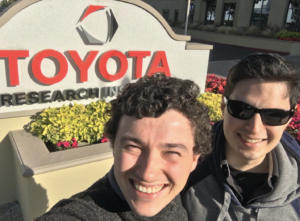Luck and learning

Steven Torrisi and Matthew Carbone outside the Toyota Research Institute in the Bay Area. (Photo: Steve Torrisi.)
As the adage goes, luck happens when preparation meets opportunity. Department of Energy Computational Science Graduate Fellowship (DOE CSGF) recipients Steven Torrisi and Matthew Carbone have seized on good fortune to devise a machine-learning tool for classifying and analyzing results from X-ray absorption spectroscopy, or XAS. The tool could help speed the search for new materials for sustainable energy applications.
The research arose from Torrisi’s 2019 summer internship at Toyota Research Institute (TRI), located south of San Francisco, and a collaboration with Lawrence Berkeley National Laboratory, leading to a July 29 paper in NPJ Computational Materials.
Torrisi’s lucky break happened a month into his TRI work, when a colleague stopped by his desk to show him a paper from Brookhaven National Laboratory (BNL) describing a machine-learning algorithm for XAS data that could predict the atomic arrangements within materials that could absorb X-rays. Torrisi looked at the paper’s title and abstract and thought, “Oh, this is insanely relevant.” Then he examined the list of authors, he recalls, and “I fell out of my chair.” First on the list was his friend, Carbone.
Torrisi called Carbone immediately. Carbone “was stunned,” he says, to learn that their research now overlapped. “It was unbelievable.” In another coincidence, Carbone already was headed to the Bay Area in a couple of weeks. Torrisi invited Carbone to speak at TRI about his BNL research. Convincing his TRI manager to collaborate with Carbone was simple, Torrisi adds. “He said, ‘Don’t waste your good luck.’”
Building on Carbone’s expertise, the team aimed beyond their original goals. They built a machine-learning tool that not only allowed them to make structure predictions but also understand how the algorithm worked.
New materials that can capture carbon dioxide, convert sunlight into energy and catalyze chemical reactions – will be critical to support sustainable energy sources. But to discover these materials, researchers need better, faster ways than those currently available to find new compounds, analyze their features and optimize their most promising properties.
XAS lets researchers probe the electrons surrounding metal ions, providing clues about the ions’ charge and how they’re connected. These configurations and changes in them are critical to understanding the surrounding structure and their role in chemical reactions. The search for new functional materials can require analyzing thousands, if not millions, of compounds and their spectral data. That’s where artificial intelligence can speed the search and analysis.
Torrisi, a Harvard University physics Ph.D. student, has focused on using machine learning to study structural properties, particularly those of catalysts. For his 2018 practicum at Lawrence Berkeley National Laboratory, he worked with Kristin Persson, director of the Materials Project. There, Torrisi used high-throughput strategies to discover two-dimensional materials that could serve as photocatalysts, compounds that harness light to break up carbon dioxide, a step toward producing sustainable fuels.
The Materials Project participates in multiple industry partnerships, and Torrisi was intrigued by public-private research collaborations. As he concluded his practicum research, he remained in contact with his Berkeley Lab colleagues, one of whom, Joseph Montoya, took a position at TRI. He encouraged Torrisi to apply for an internship at the institute’s campus in Los Altos, California.
Carbone and Torrisi had met in an undergraduate physics class at the University of Rochester in 2012 and stayed in contact as both went to graduate school and entered the DOE CSGF program, which each year selects two dozen or so of the nation’s top graduate-student scientists from hundreds of applicants. Carbone pursued Ph.D. research in theoretical chemistry at Columbia University, but started working on machine learning and materials science during his 2018 BNL practicum with Shinjae Yoo.
After bringing in Carbone, the team decided to build a machine-learning tool, a type known as random forest, that not only classified XAS data but also provided them with a way to understand how the algorithm made predictions. Although a key selling point of artificial intelligence is its ability to find data patterns, researchers don’t automatically know whether that sorting is based on scientific principles.
But in this work, the researchers featurized the spectra – breaking them into parts such as individual peaks, valleys, slopes and plateaus – as they fed them into their algorithm. As a result, the team can examine which combinations led to a prediction and interpret the underlying physics that gave rise to those features.
Their algorithm is good at predicting a metal atom’s coordination, the arrangement of other atoms around a metal ion, Torrisi says, but it also gives information about the metal ion’s charge and the amount of spacing between those atoms and their nearest neighbors. At this stage, these algorithms work with computationally generated XAS spectra, from the Materials Project database and others produced in similar ways, because generating large, curated experimental datasets would require substantial time and effort. But Torrisi expects that this work could be expanded and improved by analyzing more XAS data from different material types and, eventually, by analyzing spectra from experiments.
The project was mutually beneficial. Carbone enjoyed the opportunity to apply his machine-learning knowledge in a new environment. And Carbone’s experience helped the team avoid problems and pitfalls, easily shaving off weeks of work, Torrisi says. “Matt put a little more octane in the gas tank.”
About the Author
Sarah Webb is science media editor at the Krell Institute. She’s managing editor of DEIXIS: The DOE CSGF Annual and producer-host of the podcast Science in Parallel. She holds a Ph.D. in chemistry, a bachelor’s degree in German and completed a Fulbright fellowship doing organic chemistry research in Germany.




